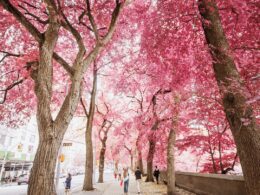For many people, the fall is a magical time of year. The most distinguishing feature of the fall is the color of the leaves. Each year thousands of trees seem to come alive, as their leaves turn from green to red, orange, yellow or even purple. One of my favorite activities in the fall is to ride bikes around town and see all the changing leaves. For a truly spectacular show, try heading up to the mountains on a scenic drive. If you are like me and you enjoy the changing leaves, you may want to plant one in your own yard. This will give you a front row seat to one of the greatest shows nature can offer. This article will outline some amazing options for you to plant if you want fall trees that will give you vibrant colored leaves this fall.
Sugar Maple
Most maple trees are considered royalty in the foliage world. Maple trees have beautifully vibrant leaves in the fall. The Sugar Maple is no exception. Sugar Maples are at the top of most colorful fall trees lists. Tree watching enthusiasts will sometimes drive hundreds of miles to get a good glimpse of a Sugar Maple tree in action. These fall trees can be found in all but the very warmest climates in the United States. Not only does a sugar maple tree have multiple shades of green during the summer, but it will cycle through yellow, orange, and red in the fall. This ever changing and diverse tree is truly a spectacular sight during the fall. Another added bonus is that the Sugar Maple tree is the number one provider of maple syrup. If you are lucky enough to tap into one, you can harvest this sweet breakfast staple.
Red Maple
Another maple worth keeping an eye out for is the Red Maple. This may be one of the most aptly named trees. All year long there is at least a little bit of the tree that is red. However, come fall time the Red Maple tree will truly ignite as its leaves turn to a vibrant bright red sea of leaves. The red leaves produced by these fall trees will often have bright yellow mixed into the foliage as well. These large trees make a dramatic display of foliage during the fall time. Like its cousin the Sugar Maple, a Red Maple can be found in nearly every climate in the United States. The abundance of the Red Maple coupled with it’s bright red leaves makes this one of the most iconic fall leaves tree to look out for.
Aspen
If you live in the west, then you probably think of Aspen trees when you think of fall trees. Along with the beautiful display of color in the fall, these trees have another beautiful effect. Aspen trees are sometimes referred to as quaking aspen. This is because these fall trees have thousands of tiny circular leaves that turn a bright yellow during the fall. When the wind blows through these leaves they sort of shimmer and shake, this gives the illusion that the tree is “quaking”. This quaking not only looks cool, but it sounds amazing. So next time you find yourself in an Aspen grove, take a minute to close your eyes and listen as well. Aspen trees are found all over the Rocky Mountain range. Because these fall trees are surrounded by the deep green of the pine trees, their leaves really pop once they turn yellow.
Sourwood
The Sourwood is a great tree to place on your fantastic fall trees list. Each summer this tree produces many small white flowers. These flowers have a light and sweet fragrance that is not only attractive to humans, but also to bees. In the fall, the leaves on this tree turn to red, yellow or even purple. After those beautifully colored leaves fall, the tree is left with only dry seed capsules left behind from the flowers.These pods create a unique winter display when the branches are bare. Unlike many fall trees, the sourwood isn’t found throughout the United States. In fact, this tree is most likely to be found in the southern states. You can expect to see a Sourwood tree grow as large as 60 feet in the wild. However, if planted domestically this tree typically stays around 25 feet.
Sassafras
Another one of our favorite fall trees is the Sassafras tree. The Sassafras tree is easily identified by its irregular shaped leaves and its aromatic properties. Unlike most fall leaves, the Sassafras tree grow lobed leaves. During the fall those lobed leaves can turn any combination of deep orange, scarlet, yellow and even pink. The Sassafras tree is native to the Eastern United States, but can be found as far south as Texas. Not only is this tree beautiful to look at, but it is extremely useful. Since the early colonial days, Americans have been using every part of the Sassafras tree for medicinal, aromatic, and culinary uses. Traditionally, one of its most famous uses was as the main ingredient in root beer. However, most commercial root beers no longer use Sassafras to flavor this classic beverage.
Japanese Maple
Another maple tree to keep your eye out for is the Japanese Maple. Unlike other varieties of maple trees, the Japanese Maple is a short tree. It has a compact and non-invasive root system which makes it great for planting along pathways and other structures. This beautiful tree typically displays its deep purple and red leaves all year long. Although, in warmer climates the red leaves may go green during the summer months. Because these trees do not love the extreme heat, they are typically found in more mild climates. The Japanese Maple tree requires almost no pruning. If you do prefer the tree to be shaped, this tree is also great for those arborists hoping to practice to art of bonsai. A gentle and artistic pruning technique. Once the tree has been delicately pruned and shaped, it will be easier to display its beautiful purple and red leaves.
Dogwood
A dogwood tree is pretty underrated as far as fall trees are concerned. Most people tend to think of a dogwood tree as a flowering tree. Typically making springtime the time of year to watch out for dogwood trees. However, when fall comes rolling around dogwood trees leaves will turn a bright shade of red. Not only is the dogwood tree appreciated by humans, but it is a favorite among wildlife. Dogwood trees produce a fruit that draws many species of birds to nest in dogwood trees. The fruit of the Dogwood tree ripens throughout the summer, and by fall time all the migrating birds can stop and eat the fruit on their migrations towards the south. This tall tree is beautiful year round, but especially in the fall and should definitely be on your favorite fall trees list.
Sumac
Sumac trees are easy to grow. This makes Sumac trees a fantastic option for those looking to add festive foliage to their backyards this fall. Just like the Dogwood tree, the Sumac tree provides food for a variety of birds. Robins, Blue Birds, and other species of bird seek out the Sumac tree so they can eat the winter berries. The berries can also be dried and ground into a spice that is frequently found in Middle Eastern cooking to add a tart almost citrus flavor to meat. While the Sumac tree is a delight for all, beware of its cousin the Poison Sumac. A Poison Sumac is similar to Poison Ivy or Poison Oak, in that it produces an oil that will cause severe allergic reactions. The Poison Sumac is easily identified by the white fruit found on the tree, as opposed to the red fruit on the Sumac tree.
In Conclusion
It doesn’t matter if you are just looking for beautiful fall trees this season or if you are hoping to plant one in your yard. There is beauty to be found in many varieties of fall trees. Hopefully, this list of gorgeous fall trees will inspire you to enjoy the vibrantly colored leaves while they are here. The color changing leaves don’t last long, and soon they will be on the ground ready to be raked, bagged and thrown away. So get outside this fall to enjoy the gorgeous vibrant colors these fall trees have to offer. Whether you go on foot, bike, or car it doesn’t matter, so long as you don’t forget to enjoy the beautiful display of leaves on these fall trees.















